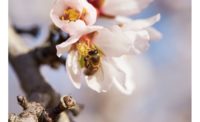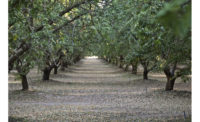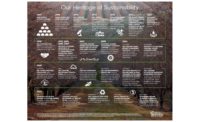Preceding the start of the annual almond pollination season in February, the California almond community is launching a new five-point Pollinator Protection Plan. A collection of important initiatives aimed at protecting bees during almond bloom and beyond, this new plan reaffirms the industry's long-standing commitment to researching, protecting and improving honey bee health.
Pollinators are essential to the production of many nutrient rich fruits, vegetables, and nuts, including almonds.1 In fact, every almond that is produced exists because a honey bee pollinated an almond blossom.
"Protecting and improving honey bee health during the short time that bees are in our orchards is critical to the success of every almond farmer. By working with national pollinator organizations, we are also engaging with partners who impact the health of bees during the other ten months that they spend outside of almonds," said Josette Lewis, PhD, director of Agricultural Affairs at the Almond Board of California (ABC).
Pollinator Protection Plan
1. Announcing a New Partnership
Today marks the start of a new partnership between ABC and the world's largest non-profit dedicated exclusively to the protection and promotion of pollinators and their ecosystems, the Pollinator Partnership. Known for their local and regional initiatives, like National Pollinator Week, the Pollinator Partnership's Bee Friendly Farming program engages farmers in the promotion of pollinator health on their lands. Farmers who meet six specific criteria can then be certified as "bee friendly."
Under this new partnership, ABC is working with Pollinator Partnership to integrate the Bee Friendly Farming program with the California Almond Sustainability Program's (CASP) bee health module. The goal of this new partnership is to expand the number of almond farmers who provide a habitat for all pollinators on their farms.
"Pollinator Partnership's Bee Friendly Farming Certification is a perfect conduit to increase pollinator benefits and to ensure protection and sustainability within the almond industry. Almond growers are terrific partners in best management practices, and we look forward to a close and growing relationship in support of pollinators and producers," said Laurie Adams, president and CEO of Pollinator Partnership.
2. Educating Farmers and other Pollination Stakeholders
In partnership with universities, government agencies, beekeepers and others, ABC established the Honey Bee Best Management Practices (BMPs) in the fall of 2014. The Bee BMPs provide recommendations to everyone involved in the pollination process to ensure almond orchards are a safe and welcoming place for honey bees, while balancing the need to protect the developing crop.
Since their release, ABC has communicated the important practices outlined in these guidelines with California's almond farmers, pest control advisers, beekeepers, and other pollination stakeholders. As a result, over 90% of almond farms report following the Honey Bee BMP recommendations.2
To further communicate these important practices, ABC is taking that education straight into the field with a series of in-orchard workshops in the next two weeks covering the Bee BMPs as well as the benefits of planting bee pastures and cover crops. Held at farms throughout the California's almond growing region, these workshops provide a venue for farmers to learn from industry experts, collaborate with their peers and observe recommended practices in action.
3. Promoting Tools for Improved Communication
In conjunction with state government and partners in the bee and agricultural industry, ABC is supporting the development and launch of BeeWhere, a new digital mapping tool debuting this year, to make life simpler for beekeepers and farmers while helping to protect honey bees.
California law requires beekeepers to register their hive locations with County Agricultural Commissioners. Previously accomplished by physically noting locations on a map, BeeWhere offers a real-time GIS mapping system where beekeepers can mark their hives using a mobile app. Farmers and their pest control advisers can then access information about the number of bee hives nearby, allowing them to adapt their practices should they need to apply a pesticide to protect the developing crop.
In advance of this year's bloom, ABC is partnering with the California State Beekeepers Association to help get the word out, so all stakeholders are able to utilize this important new tool.
4. Increasing Floral Diversity On-Farm
While almond pollen alone is very nutritious for honey bees, providing all ten of the amino acids their diets require3 and giving them a strong start to the year,4 research shows that bees fare even better with increased diversity of pollen sources.
Working with bee research organization Project Apis m. and others, ABC is encouraging farmers to plant bee pastures and hedgerows within or adjacent to their orchards as additional food sources for all pollinators, including native bees. Since 2013, almond farmers have planted 34,000 acres of bee pasture through Project Apis m.'s Seeds for Bees program.5 Beyond the benefits to pollinators, these plantings also help farmers improve soil health, water infiltration and more.
5. Supporting Bee Health Research
Through ABC, California's almond farmers have funded more honey bee health research than any other crop group.6 This year, ABC is funding five new studies with leading bee experts across the U.S. to improve honey bee health.
Since ABC made honey bee health a strategic research priority in 1995, the California almond community has supported 125 research projects to address the five major factors impacting honey bee health – varroa mites, pest and disease management, lack of genetic diversity, pesticide exposure and access to forage and nutrition.
The Almond Board of California is a leader in the honey bee health conversation, and these efforts build on existing partnerships with more than 20 bee health organizations spanning universities, government agencies, nonprofits and beekeeping groups.
"Responsible farming is at the heart of what the California almond community does," said Lewis. "Whether it is bee health, water efficiency, or other important sustainability areas, we stand committed to growing almonds in better, safer and healthier ways."
To learn more about the mutually beneficial relationship between almonds and bees, along with the California almond community's commitment to protecting and improving honey bee health, visit Almonds.com/Bees.







